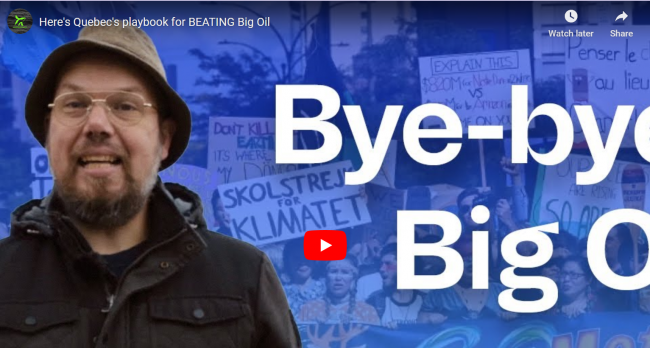Articles Menu

Jan 10 2024
Watch here: https://youtu.be/48QpstQLv6Q
Dru Oja Jay: A few years ago, a movement with hundreds of thousands of participants achieved a stunning climate justice victory, one of the world’s biggest examples of leaving fossil fuels in the ground.
The action that took place right here, young people perched on tripods blocking roads, or locked to the gates of oil distributors, was just one step in the vast movement that shut down oil and gas extraction in this province.
In 2022, Quebec became the world’s first government to ban oil and gas drilling. A determined social movement made it happen. Here’s Quebec’s playbook for beating Big Oil.
In the early 2010s, Quebec’s oil consumption was around 350,000 barrels per day.
But the fossil fuel industry’s plans would have made the province into an expanding oil-and-gas hub, transporting four times that amount over its lakes, rivers and seaways.
Researchers saw this expansion coming.
They identified harmful chemicals that would be used in fracking, deep-sea drilling, and pipelines. Then, they mapped which waterways would be at risk for spills and leaks.
Armed with this information, local organizers effectively communicated about the potential local impacts, as well as the implications for the climate worldwide.
In kitchens, churches, and community centres, deep mobilizing reached every sector of society. A variety of organizations helped turn onlookers into supporters and supporters into activists.
Organizers built relationships across cultural divides and fault lines.
And the movement was made up of smaller local struggles unified by a single vision. Whether it was shale gas in the St. Lawrence Valley, oil drilling in Anticosti, or undersea drilling near Îles de la Madeleine, each group focused on local concerns but saw themselves as part of a larger movement.
Organizing and deep mobilizing set the stage, but it was the possibility of direct action that threatened the financial viability of these extraction projects. Local groups planned mass non-violent direct actions to physically stop extraction. Some blocked pipeline sites, risking arrest and placing their bodies in the way of machinery.
But for every protester willing to go to jail, dozens were there to offer their support.
That support took the form of donations for legal aid, places to stay, or as one person put it, “tiny sandwiches.”
Artists and musicians created common experiences and a language of resistance that spread deeper into public consciousness than any activist press release could. Bands performed to keep activists and their resistance lively.
But some of Quebec’s high-profile acts also took a stand, whether it was Les Cowboys Fringants, or future provincial party leader Gabriel Nadeau-Dubois, who donated a $25,000 literary prize to a movement group dedicated to stopping fossil fuel extraction.
Local artisans even launched an anti-pipeline beer.
The movement didn’t only say, “No.” It offered an inspiring “Yes.” A wave of student climate strikes was followed by a giant climate demonstration attended by 500,000 people in Montreal.
Quebec has a unique history and context.
Without using it as a cut-and-paste plan, their playbook for beating Big Oil offers us plenty of inspiration at a time when climate action will determine our future and that of future generations.